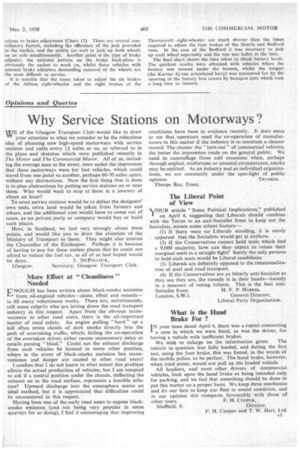Maintenance Tests Analysed
Page 92

Page 93

If you've noticed an error in this article please click here to report it so we can fix it.
Qthe 27 vehicles tested on the road during the past "--/12 months, maintenance tasks were -conducted on as many of them as time would allow. The times taken to perform various routine jobs are shown in the accompanying charts.
Chart 7 deals with the times taken to check the level of the engine oil in 15 different vehicles. It is, perhaps, significant that the shortest time recorded was on the Austin 2-tonnera normal-control vehicle offering the best possible engine accessibility. The long time (105 sec.) quoted for the Bedford 12-cwt van was occasioned partly by the difficulty of replacing the dipstick. This is, indeed, one of the principal reasons for lengthy times when performing this task.
Fourteen gearbox oil-level checks were made. In most cases there is a combined filler and level plug, but on certain vehicles this is not easy to use as a. filler plug because of the position of the hole. The shortest checks were made on those vehicles in which a dipstick was provided. The time quoted for the Foden is somewhat long, but this was partly because the plug threads were tight.
Times occupied in checking rear-axle oil levels arc shown in Chart 9 and here, again, most of the vehicles have combined filler and level plugs. The times for the Thornyeroft and Albion eight-wheelers are much longer than the others because these vehicles had two driving axles.
Removal and replacement of a sparking plug is not always the simple job it should be, mainly because of the number of panels that have to be removed on certain vehicles to give sufficient room for a conventional plug spanner to be applied. Once again the advantage of a normal-control design is shown by the speed at which a plug was changed on the Austin 2-ton chassis.
Times quoted for injector removal and replacement do not give a true indication of the accessibility of this component, as it is often found that, although an injector might be easy to reach, it sticks in its bore and is difficult to remove. This Eccounts for the long times for the Foden and Bedford, whilst the four minutes spent on the Guy shows how quickly an injector can be changed if everything is in the fitter's favour.
Possibly the biggest range of times for a particular job relates to brake adjustment (Chart 12). There are several contributory factors, including the efficiency of the jack provided in the toolkit, and the ability (or not) to jack up both wheels on an axle simultaneously. Another point is the type of brake adjuster, the external pattern on the brake back-plate is obviously the easiest to work on, whilst those vehicles with internal brake adjusters demanding removal of the wheels are the most difficult to service.
It is notable that the times taken to adjust the six brakes of the Albion eight-wheeler and the eight brakes. of the
Thorny-croft eight-wheeler are much shorter than the times required to adjust the four brakes of the Morris and Bedford vans. In the case of the Bedford it was necessary to jack up each wheel separately and the van was laden at the time.
The final chart shows the time taken to check battery levels. The quickest results were obtained with vehicles where the battery was stowed under the bonnet, whilst the longest (the Karrier 4i-ton articulated lorry) was accounted for by the securing of the battery box covers by hexagon nuts which took a long time to remove.




















































































































































































































































